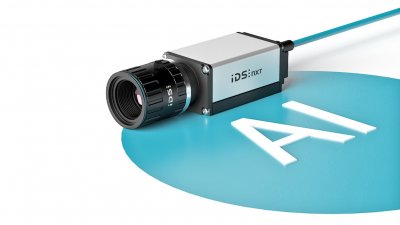Schlagwort-Archiv: NXT
IDS NXT malibu now available with the 8 MP Sony Starvis 2 sensor IMX678
Intelligent industrial camera with 4K streaming and excellent low-light performance

IDS expands its product line for intelligent image processing and launches a new IDS NXT malibu camera. It enables AI-based image processing, video compression and streaming in full 4K sensor resolution at 30 fps – directly in and out of the camera. The 8 MP sensor IMX678 is part of the Starvis 2 series from Sony. It ensures impressive image quality even in low light conditions and twilight.
Industrial camera with live AI: IDS NXT malibu is able to independently perform AI-based image analyses and provide the results as live overlays in compressed video streams via RTSP (Real Time Streaming Protocol). Hidden inside is a special SoC (system-on-a-chip) from Ambarella, which is known from action cameras. An ISP with helpful automatic features such as brightness, noise and colour correction ensures that optimum image quality is attained at all times. The new 8 MP camera complements the recently introduced camera variant with the 5 MP onsemi sensor AR0521.
To coincide with the market launch of the new model, IDS Imaging Development Systems has also published a new software release. Users now also have have the the option of displaying live images from the IDS NXT malibu camera models via MJPEG-compressed HTTP stream. This enables visualisation in any web browser without additional software or plug-ins. In addition, the AI vision studio IDS lighthouse can be used to train individual neural networks for the Ambarella SoC of the camera family. This simplifies the use of the camera for AI-based image analyses with classification, object recognition and anomaly detection methods.
Free update makes third deep learning method available for IDS NXT
Update for the AI system IDS NXT: cameras can now also detect anomalies

In quality assurance, it is often necessary to reliably detect deviations from the norm. Industrial cameras have a key role in this, capturing images of products and analysing them for defects. If the error cases are not known in advance or are too diverse, however, rule-based image processing reaches its limits. By contrast, this challenge can be reliably solved with the AI method Anomaly Detection. The new, free IDS NXT 3.0 software update from IDS Imaging Development Systems makes the method available to all users of the AI vision system with immediate effect.

The intelligent IDS NXT cameras are now able to detect anomalies independently and thereby optimise quality assurance processes. For this purpose, users train a neural network that is then executed on the programmable cameras. To achieve this, IDS offers the AI Vision Studio IDS NXT lighthouse, which is characterised by easy-to-use workflows and seamless integration into the IDS NXT ecosystem. Customers can even use only „GOOD“ images for training. This means that relatively little training data is required compared to the other AI methods Object Detection and Classification. This simplifies the development of an AI vision application and is well suited for evaluating the potential of AI-based image processing for projects in the company.
Another highlight of the release is the code reading function in the block-based editor. This enables IDS NXT cameras to locate, identify and read out different types of code and the required parameters. Attention maps in IDS NXT lighthouse also provide more transparency in the training process. They illustrate which areas in the image have an impact on classification results. In this way, users can identify and eliminate training errors before a neural network is deployed in the cameras.
IDS NXT is a comprehensive AI-based vision system consisting of intelligent cameras plus software environment that covers the entire process from the creation to the execution of AI vision applications. The software tools make AI-based vision usable for different target groups – even without prior knowledge of artificial intelligence or application programming. In addition, expert tools enable open-platform programming, making IDS NXT cameras highly customisable and suitable for a wide range of applications.
More information: www.ids-nxt.com
2D, 3D and AI: IDS presents numerous new products and camera developments at VISION
Today, cameras are often more than just suppliers of images – they can recognise objects, generate results or trigger follow-up processes. Visitors to VISION Stuttgart, Germany, can find out about the possibilities offered by state-of-the-art camera technology at IDS booth 8C60. There, they will discover the next level of the all-in-one AI system IDS NXT. The company is not only expanding the machine learning methods to include anomaly detection, but is also developing a significantly faster hardware platform. IDS is also unveiling the next stage of development for its new uEye Warp10 cameras. By combining a fast 10GigE interface and TFL mount, large-format sensors with up to 45 MP can be integrated, opening up completely new applications. The trade fair innovations also include prototypes of the smallest IDS board-level camera and a new 3D camera model in the Ensenso product line.
IDS NXT: More than artificial intelligence
IDS NXT is a holistic system with a variety of workflows and tools for realising custom AI vision applications. The intelligent IDS NXT cameras can process tasks „on device” and deliver image processing results themselves. They can also trigger subsequent processes directly. The range of tasks is determined by apps that run on the cameras. Their functionality can therefore be changed at any time. This is supported by a cloud-based AI Vision Studio, with which users can not only train neural networks, but now also create vision apps. The system offers both beginners and professionals enormous scope for designing AI vision apps. At VISION, the company shows how artificial intelligence is redefining the performance spectrum of industrial cameras and gives an outlook on further developments in the hardware and software sector.

uEye Warp10: High speed for applications
With 10 times the transmission bandwidth of 1GigE cameras and about twice the speed of cameras with USB 3.0 interfaces, the recently launched uEye Warp10 camera family with 10GigE interface is the fastest in the IDS range. At VISION, the company is demonstrating that these models will not only set standards in terms of speed, but also resolution. Thanks to the TFL mount, it becomes possible to integrate much higher resolution sensors than before. This means that even detailed inspections with high clock rates and large amounts of data will be feasible over long cable distances. The industrial lens mount allows the cameras to fully utilise the potential of large format (larger than 1.1″) and high resolution sensors (up to 45 MP).
uEye XLS: Smallest board-level camera with cost-optimised design
IDS is presenting prototypes of an additional member of its low-cost portfolio at the fair. The name uEye XLS indicates that it is a small variant of the popular uEye XLE series. The models will be the smallest IDS board-level cameras in the range. They are aimed at users who, e.g. for embedded applications, require particularly low-cost, extremely compact cameras with and without lens holders in large quantities. They can look forward to Vision Standard-compliant project cameras with various global shutter sensors and trigger options.
Ensenso C: Powerful 3D camera for large-volume applications
3D camera technology is an indispensable component in many automation projects. Ensenso C is a new variant in the Ensenso 3D product line that scores with a long baseline and high resolution, while at the same time offering a cost-optimised design. Customers receive a fully integrated, pre-configured 3D camera system for large-volume applications that is quickly ready for use and provides even better 3D data thanks to RGB colour information. A prototype will be available le at the fair.
Learn more: https://en.ids-imaging.com/ueye-warp10.html
LegoWorld Utrecht 2018 Photos
EV3 Sensor Adapter for NXT or Arduino
I just stumbled across the following on the mindsensors.com products:
EV3 Sensor Adapter for NXT or Arduino
Using this adapter, you can attach new EV3 sensors to your NXT or Arduino.
(This is basically a UART to I2C adapter).
- For NXT, works with BricxCC, and new EV3 IDE for NXT
- Lightweight and small design, that fits in-line with your sensor and brick
- Use with Arduino with NXShield
I will test this adapter in the near future and write more about it here. Because the adapter is not supporting NXT-G, but the new EV3 IDE together with the NXT brick, this will then also be my first time using the new software with the „old“ NXT hardware.
OHM2013: Hacking the brick
Roberta Basketball Arm CAD – Zeitraffer – YouTube
LegoWorld Videos from botbench.com
Xander Soldaat from botbench.com has taken some videos. The corresponding blog entries can be found here: http://botbench.com/blog/category/ramblings/
LEGOWorld – Day 0 – Tue 18 October 2011
LEGOWorld – Day 1 – Wed 19 October 2011
LEGOWorld – Day 3 – Fri 21 October 2011
LEGOWorld – Day 4 – Sat 22 October 2011
LEGOWorld – Day 5 – Sun 23 October 2011
Videos from Legoworld Zwolle 2011
Lego Mindstorms NXT Brickbot at Legoworld 2011 Zwolle
(remote controlled via Bluetooth Android mobile phone)
A flying NXT!
A Lego Mindstorms NXT Vending Machine























